I’ve been having a bit of an existential crisis over textures in the game. I made a model of a crate with some textures from opengameart.org (which is fantastic, by the way) and loaded it into Penrith Forest. It looks good and really wasn’t difficult to export from Blender or load into my scene. Since using textures is definitely a technical possibility I’m willing to concede that I will probably eventually move away from the materials-only low poly style. That being said, there’s no reason to freak out about it right now. Once the game is much more deeply developed I plan on giving players the ability to submit art work for inclusion in the game so maybe at that point I can bring in some artists with some actual talent for creating assets using textures. For now, though, I’m sticking with my simple style and I’ll just brighten the fur material on my test boar so I can see him a bit better. Crisis averted, for now.
Beginning with enemies
Planning and DevelopmentI thought I would start on implementing enemies and a battle system. To do that I needed an enemy to work with. Staying in line with standard MMORPG tradition, I decide to make a boar. Look at this adorable fella:
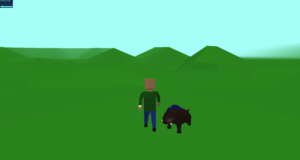 Full disclosure, he kind of looks more like a bulldog than a boar, and it has creepy human eyebrows that I’m not sure why I made, but I’m an amateur 3D modeler, so cut me some slack. It can always be improved later.
Full disclosure, he kind of looks more like a bulldog than a boar, and it has creepy human eyebrows that I’m not sure why I made, but I’m an amateur 3D modeler, so cut me some slack. It can always be improved later.
Anyway, I stuck one in Penrith Forest just to get a look at it in the game and now I’m worried. One of my starting goals was to creating everything in Lyridia without textures. There are several reasons for this. It makes asset creation simpler, it make asset exporting simpler, and it keeps the file sizes for the assets very small. The boar model has around 600 triangles and the exported .json file is 40KB. That’s tiny, which is great, but I’m worried that I’ll never be able to get my assets to look very good without textures. Things like eyes, fur, dirt, scars, etc., etc., may just be impossible to create convincingly without textures. The thing about all this is that I’m not an evangelist for a particular art style. I wasn’t interested in using only materials because I have a vested interest in not using textures. The bandwidth and rendering efficiency was my only concern. If, however, I can use textures and still keep my file sizes small I’m all for it. I guess I just really need to do some testing to see how difficult it is to use textures in my assets and keep everything straight, and how much larger the required files will be.
Basic user interaction
Planning and DevelopmentI’m working on the very basics of letting users interact with the world and I’ve started with the cursor highlighting objects in the world. You can only highlight an object if it’s in the correct group, and if the camera is close enough to it. The guy in the yellow shirt is highlighted here:
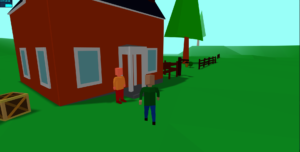 It’s not perfect but it’s a start on letting users select and interact with NPCs.
It’s not perfect but it’s a start on letting users select and interact with NPCs.
Windowed mode
Planning and DevelopmentI’ve added the ability to run Lyridia in a “window.”
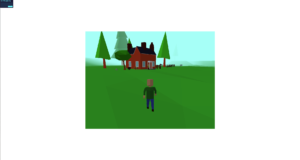 This is the game running at a resolution of 800×600. You can see on my under-powered test machine that the game hits about 30FPS (right now) by doing this. I can also scale the the game itself but it gets pretty garbled pretty quickly if you go below about 75%.
This is the game running at a resolution of 800×600. You can see on my under-powered test machine that the game hits about 30FPS (right now) by doing this. I can also scale the the game itself but it gets pretty garbled pretty quickly if you go below about 75%.
There’s obviously something about this I’m not getting right now, which is actually encouraging, because if I run the game at 800×600 then shrink the browser window down to remove the white space around the game display, I get this:
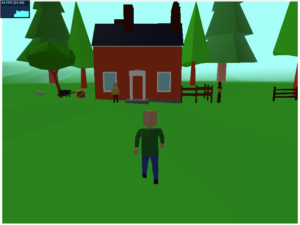 Notice the FPS is up to almost 60. I don’t know if the browser is wasting a bunch of resources clearing and redrawing the big white border in the first shot, or if it’s some other process I don’t understand, but in any case the game can, right now, be run at nearly 60FPS at a resolution of 800×600 on my terrible test machine and that’s exciting.
Notice the FPS is up to almost 60. I don’t know if the browser is wasting a bunch of resources clearing and redrawing the big white border in the first shot, or if it’s some other process I don’t understand, but in any case the game can, right now, be run at nearly 60FPS at a resolution of 800×600 on my terrible test machine and that’s exciting.
Shadows
Planning and DevelopmentI saw first-hand today something that I already knew. Shadows are expensive. One of my test machines is an old PC currently running Ubuntu 18.04 LTS. It has an Intel® Core™2 Duo CPU E8500 @ 3.16GHz and 8GB of RAM. Needless to say, this isn’t a powerful machine. The processor scored a 2286 on the Passmark benchmark test. By comparison a $1,000 gaming PC you can buy on Newegg right now has an Intel® Core™ i7-8700K @ 3.70GHz with a score of 16034. And that’s completely ignoring the graphics card. My point is, if the game will run on this test machine it should run just about anywhere. Without shadows I get 20-25 FPS on a 1920×1080 monitor. If I knock that down to 1024×768 I get about 40 FPS. If I turn on shadows, however, my FPS at 1920×1080 is around 5. 5 FPS! If I size the window to 1024×768 it shoots up to about 12. This is why I want to build the game from the ground up to be as configurable as possible by the players. If you want fancy effects and have a fast computer, go for it. If your machine is kind of old and you don’t care so much about the visuals, turn them off. If you have a clunker but want to see all the cool effects and don’t mind a horrible frame rate, jump right in!
This will take some effort throughout development but I think it’s worth it to give players some control over their own experience rather than dictating a certain set of hardware requirements to enjoy the game.
Next steps
Planning and DevelopmentThese are things that need to be implemented in Lyridia, in no particular order. I’m just putting them here as a reference so I can think about how I want to proceed.
- Collision detection
- NPCs
- Enemies
- HUD
- Better camera controls
- Multiplayer
This is a short list of some very big items. Each will need to be broken way down but this gives me something to be thinking about.
v00001
Release AnnouncementYou can now run Chronicles of Tright: Lyridia – v00001. That link will eventually be incorrectly titled because it just points to the latest available version of the game and that should change very soon. That’s really neither here nor there because you can now go PLAY THE GAME*!!! I’ve put an asterisk beside the word “game” because there aren’t any real “game” features at this time. All you can really do is use the ‘wasd’ keys to walk around. But it’s a start. So, if you’re into walking around very small 3D scenes feel free to check it out.
The list of things the game doesn’t do is much, much longer than the list of things it does do. Of course, I guess that’s technically true of any game. Like, World of Warcraft doesn’t make you toast, or clean your house. I digress. What it does do is draw a scene you can walk around in. You stay grounded on the terrain and you are magic because you can walk through buildings and trees. It makes some shadows and hides things that are too far away from you in fog. That’s really about it. I’ll be finalizing the list of features to include v00002 over the next few days then hopefully have another release shortly after that.
Well that didn’t take long
Planning and DevelopmentI wanted to get some really basic walking around functionality built and it’s done.
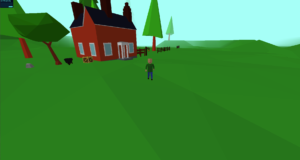 This is still running in the development code branch but I will clean things up a bit later tonight then release it as the very first version of the game. Don’t get too excited. There’s really no “game” functionality at this point, but I’ll post about that later.
This is still running in the development code branch but I will clean things up a bit later tonight then release it as the very first version of the game. Don’t get too excited. There’s really no “game” functionality at this point, but I’ll post about that later.
Demo scene planning
Planning and DevelopmentI’m happy with the world editor for now. I need a working version of the game so that I can see what the world actually looks like from a player’s perspective so I can tell how to add assets to Penrith Forest. It’s really easy for me to end up creatively paralyzed in situations like this so I’m going to get a basic “walking around” demo done then just start adding stuff. If it’s bad I can take it out or change it, but without something to start with I’ll never get close to a finished product. It may take me a few days to get the demo done but when I do it will be the very first version of the game and future versions will just be incremental improvements to that base, so I’m looking forward to that.
World editor lighting
Planning and DevelopmentMessing with point lights is becoming a pain so I’m going to shelf it for now. It will be an important feature eventually, but for outdoor scenes lit by the sun other lights are not really noticeable anyway. I’m going to create a few more small assets for Penrith Forest then put them in the world and edit the terain to fit around the assets. Then I’ll put together a very, very simple demo that will be the very first early alpha version of Chronicles of Tright: Lyridia.